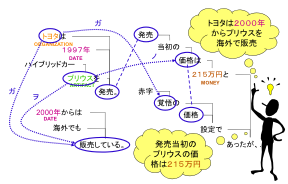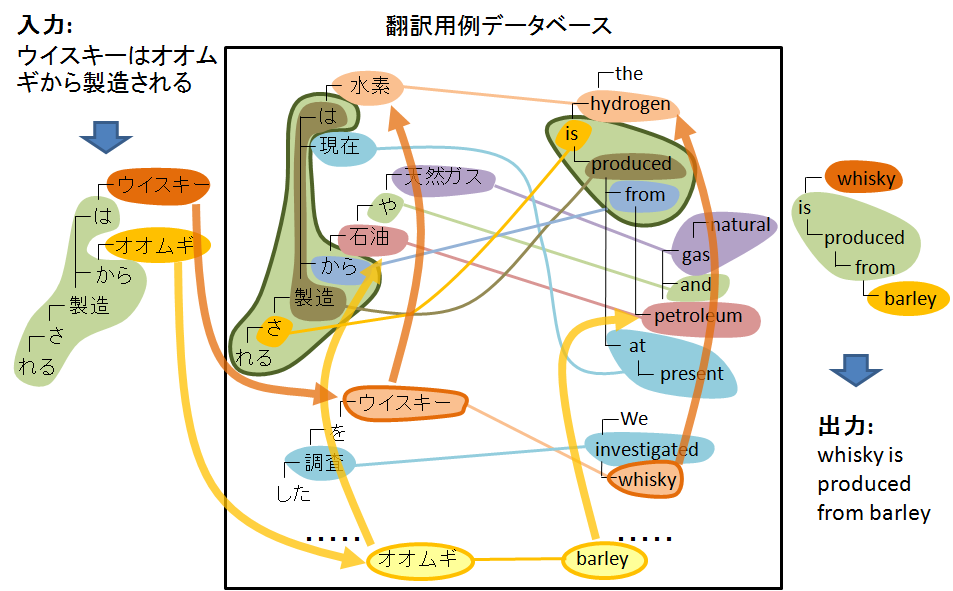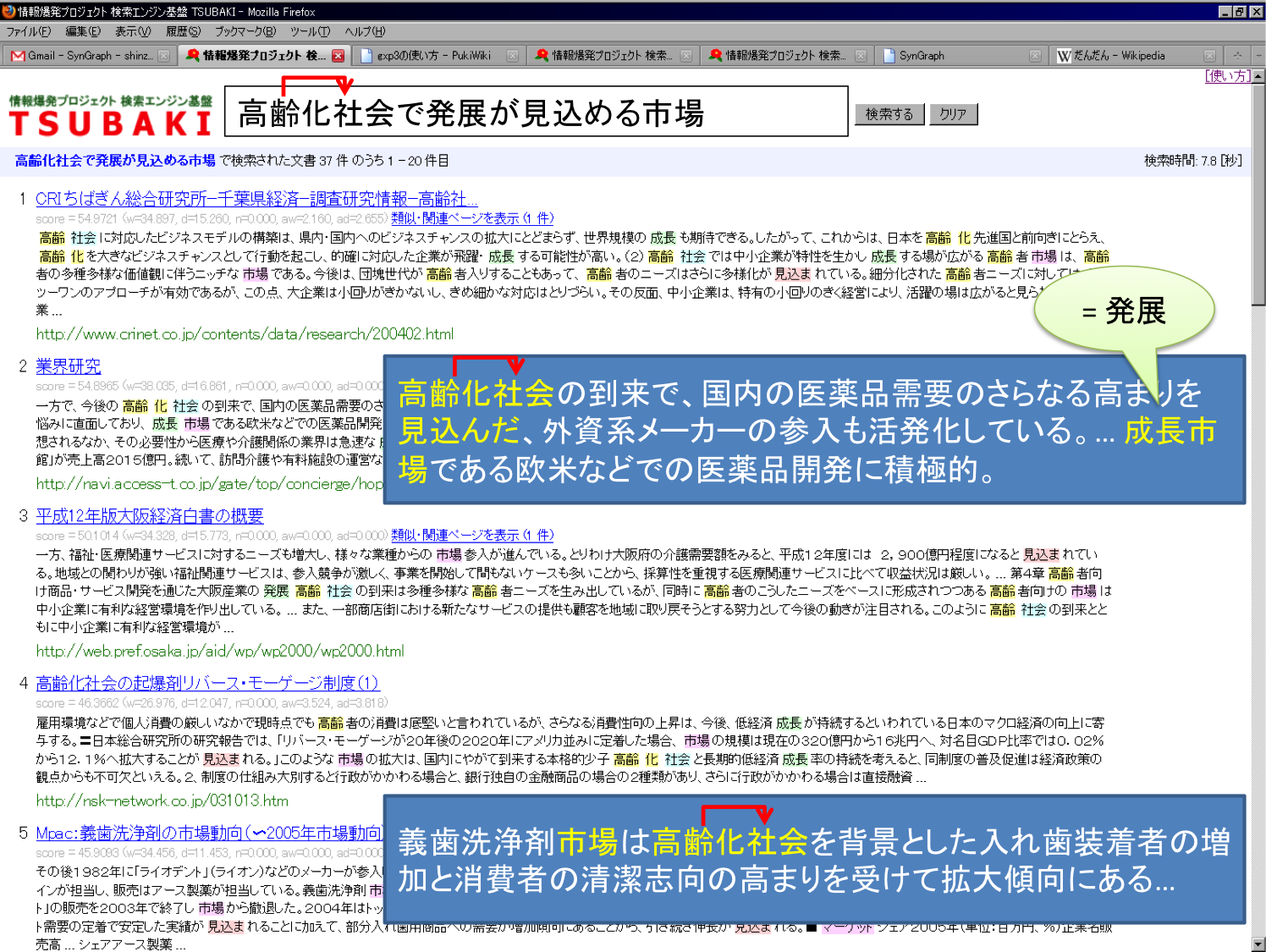Research †
Language is the most reliable medium of human intellectual activities. Our objective is to establish the technology and academic discipline for handling and understanding language, in a manner that is as close as possible to that of humans, using computers. These include syntactic language analysis, semantic analysis, context analysis, text comprehension, text generation and dictionary systems to develop various application systems for machine translation and information retrieval.
Fundamental Studies on Text Understanding †
To make computers understand language, it is essential to give
computers world knowledge. This was a very hard problem ten years ago,
but it has become possible to acquire knowledge from a massive amount
of text in virtue of the drastic progress of computing power and
network. We have successfully acquired linguistic patterns of
predicate-argument structures from automatic parses of 7 billion
Japanese sentences crawled from the Web using grid computing
machines. By utilizing such knowledge, we study text understanding,
i.e., recognizing the relationships between words and phrases in text.
Machine Translation †
To bring automatic translation by computers to the level of human
translation, we have been studying next-generation methodology of
machine translation on the basis of text understanding and a large
collection of translation examples. We have already accomplished
practical translation on the domain of travel conversation, and
constructed a translation-aid system that can be used by experts of
patent translation.
From 2006, we participate in the Japanese-Chinese translation project
by the special coordination funds for the promotion of science and
technology.
Please see KyotoEBMT and Project on Practical Implementation of Japanese to Chinese-Chinese to Japanese Machine Translation for more details.
Search Engine Infrastructure based on Deep Natural Language Processing †
The essential purpose of information retrieval is not to retrieve just
a relevant document but to acquire the information or knowledge in the
document. We have been developing a next-generation infrastructure of
information retrieval on the basis of the following techniques of deep
natural language processing: precise processing based not on words but
on predicate-argument structures, identifying the variety of
linguistic expressions and providing a bird's-eye view of search results via clustering and interaction.
PhD Alumni †
- Nobuhiro UEDA(植田 暢大) (Sep.2025; Supervisor: Prof. Sadao Kurohashi)
Cohesion Analysis of Textual and Visual Entities: Enhancing Accuracy and Comprehensiveness
- Kazumasa OMURA(大村 和正) (Sep.2024; Supervisor: Prof. Sadao Kurohashi)
Studies on Data-Driven Discourse Relation Recognition toward Natural Language Understanding
- Zhuoyuan Mao (Sep.2024; Supervisor: Prof. Sadao Kurohashi)
Breaking Language Barriers: Enhancing Multilingual Representation for Sentence Alignment and Translation
- Haiyue Song (Sep.2024; Supervisor: Prof. Sadao Kurohashi)
Studies on Subword-based Low-Resource Neural Machine Translation: Segmentation, Encoding, and Decoding
- Takashi KODAMA(児玉 貴志) (Sep.2024; Supervisor: Prof. Sadao Kurohashi)
Advancing Dialogue Systems through Corpus Construction Focusing on User Internal States and External Knowledge
- Qianying Liu (Sep.2023; Supervisor: Prof. Sadao Kurohashi)
Numerical Reasoning in NLP: Challenges, Innovations, and Strategies for Handling Mathematical Equivalency
- Tareq Alkhaldi (Sep.2023; Supervisor: Prof. Sadao Kurohashi)
Studies on Question Answering in Open-Book and Closed-Book Settings
- Hirokazu KIYOMARU (清丸寛一) (Mar.2022; Supervisor: Prof. Sadao Kurohashi)
Studies on Fundamental Problems in Event-Level Language Analysis
- Tolmachev Arseny (Mar.2022; Supervisor: Prof. Sadao Kurohashi)
Enhancing Morphological Analysis and Example Sentence Extraction for Japanese Language Learning
- Huang Yin Jou (Jul.2021; Supervisor: Prof. Sadao Kurohashi)
Event Centric Approaches in Natural Language Processing
- Shuhei KURITA (栗田修平) (Mar.2019; Supervisor: Prof. Sadao Kurohashi)
Neural Approaches for Syntactic and Semantic Analysis (cue)
- Tomohiro SAKAGUCHI (坂口智洋) (Mar.2019; Supervisor: Prof. Sadao Kurohashi)
Anchoring Events to the Time Axis toward Storyline Construction (cue)
- Raj Dabre (Mar.2018; Supervisor: Prof. Sadao Kurohashi)
Exploiting Multilingualism and Transfer Learning for Low Resource Machine Translation (cue)
- Xun Wang (Nov.2017; Supervisor: Prof. Sadao Kurohashi)
Entity-Centric Discourse Analysis and Its Applications (cue)
- John Richardson (Sep.2016; Supervisor: Prof. Sadao Kurohashi)
Improving Statistical Machine Translation with Target-Side Dependency Syntax (cue)
- Gongye Jin (Mar.2016; Supervisor: Assoc. Prof. Daisuke Kawahara)
High-quality Knowledge Acquisition of Predicate-argument Structures �for Syntactic and Semantic Analysis (cue)
- Mo Shen (Mar.2016; Supervisor: Assoc. Prof. Daisuke Kawahara)
Exploiting Vocabulary, Morphological, and Subtree Knowledge to Improve Chinese Syntactic Analysis (cue)
- Chenhui Chu (Mar.2015; Supervisor: Prof. Sadao Kurohashi)
Integrated Parallel Data Extraction from Comparable Corpora for �Statistical Machine Translation (cue)
- Isao GOTO (後藤功雄) (May.2014; Supervisor: Prof. Sadao Kurohashi)
Word Reordering for Statistical Machine Translation via Modeling Structural Differences between Languages (cue)
- Masatsugu HANGYO (萩行正嗣) (Mar.2014; Supervisor: Prof. Sadao Kurohashi)
Studies on Annotated Diverse Corpus Construction and Zero Reference Resolution in Japanese (cue)
- Tomoko IZUMI (泉朋子) (Jan.2014; Supervisor: Prof. Sadao Kurohashi)
Normalization and Similarity Recognition of Complex Predicate Phrases Based on Linguistically-Motivated Evidence (cue)
- Jun HARASHIMA (原島純) (Mar.2013; Supervisor: Prof. Sadao Kurohashi)
Studies on Re-ranking and Summarizing Search Results (cue)
- CHIKARA HASHIMOTO (橋本力) (Sep.2011; Supervisor: Prof. Sadao Kurohashi)
Knowledge Acquisition from the Web for Text Understanding (cue)
- Fabien Cromieres (Mar.2011; Supervisor: Prof. Sadao Kurohashi)
Using Scalable Run-Time Methods and Syntactic Structure in Corpus-Based Machine Translation (cue)
- Yugo MURAWAKI (村脇有吾) (Mar.2011; Supervisor: Prof. Sadao Kurohashi)
Automatic Acquisition of Japanese Unknown Morphemes (cue)
- Toshiaki NAKAZAWA (中澤敏明) (Mar.2010; Supervisor: Prof. Sadao Kurohashi)
Fully Syntactic Example-based Machine Translation (cue)
- Koichi TAKEDA (武田浩一) (Mar.2010; Supervisor: Prof. Sadao Kurohashi)
Building Natural Language Processing Applications Using Descriptive Models (cue)
- Ryohei SASANO (笹野遼平) (Mar.2009; University of Tokyo, Supervisor: Prof. Sadao Kurohashi)
Japanese Anaphora Resolution Based on Automatically Acquired World Knowledge
- Manabu SASSANO (颯々野学) (Sep.2008; Supervisor: Prof. Sadao Kurohashi)
Practical Use of Large Margin Classifiers in Natural Language Processing (cue)
- Tomohide SHIBATA (柴田知秀) (Mar.2007; University of Tokyo, Supervisor: Prof. Sadao Kurohashi)
Structural Understanding of Instruction Videos by Integrating Linguistic and Visual Information
- Daisuke KAWAHARA (河原大輔) (Jul.2005; Supervisor: Prof. Takashi Matsuyama)
Automatic Construction of Japanese Case Frames for Natural Language Understanding (cue)
- Eiji ARAMAKI (荒牧英治) (Mar.2005; University of Tokyo, Supervisor: Prof. Sadao Kurohashi)
Formalization and Realization of Example-based Machine Translation
- Nobuhiro KAJI (鍜治伸裕) (Mar.2005; University of Tokyo, Supervisor: Prof. Sadao Kurohashi)
Paraphrasing Written Language to Spoken Language
- Yoji KIYOTA (清田陽司) (Nov.2004; Supervisor: Prof. Takashi Matsuyama)
Dialog Navigator: A Navigation System from Vague Questions to Specific Answers based on Real-World Text Collections (cue)
※ The full thesis of abstract shown in this page could be found at 京都大学電気関係教室技術情報誌cue (Japanese).



